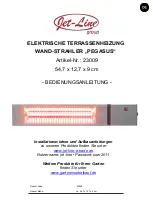
1. Do not attempt to install, repair, or service this heater
unless you have continuing expert training and
knowledge of gas heaters.
Qualifications for service and installation of this
equipment are as follows:
a. To be a qualified gas heater service person, you
must have sufficient training and experience to
handle all aspects of gas-fired heater installation,
service and repair. This includes the task of
installation, troubleshooting, replacement of
defective parts and testing of the heater. You
must be able to place the heater into a continuing
safe and normal operating condition. You must
completely familiarize yourself with each model
heater by reading and complying with the safety
instructions, labels, Owner’s Manual, etc., that is
provided with each heater.
b. To be a qualified gas installation person, you must
have sufficient training and experience to handle
all aspects of installing, repairing and altering gas
lines, including selecting and installing the proper
equipment, and selecting proper pipe and tank
size to be used. This must be done in accordance
with all local, state and national codes as well as
the manufacturer’s requirements.
c. In the Commonwealth of Massachusetts, this
product must be installed by a gas fitter licensed
by the Commonwealth of Massachusetts.
2. All installations and applications of L.B. White heaters
must meet all relevant local, state and national
codes. Included are propane gas, natural gas,
electrical, and safety codes. Your local fuel gas
supplier, a local licensed electrician, the local fire
department or similar government agencies, or your
insurance agent can help you determine code
requirements.
Also refer to:
-- ANSI/NFPA 58, latest edition, Standard for
Storage and Handling of Liquefied Petroleum
Gas and/or
-- ANSI Z223.1/NFPA 54, National Fuel Gas
Code
-- ANSI/NFPA 70, National Electrical Code.
3. We cannot anticipate every use which may be made
of our heaters. Check with your local fire safety
authority if you have questions about applications.
4. Other standards govern the use of fuel gases and
heat producing products in specific applications.
Your local authority can advise you about these.
5. Do not move, handle, or perform maintenance on the
heater while in operation or connected to a power or
fuel supply.
6. For safety, this heater is equipped with a backflash
switch. Never operate this heater with any safety
device that has been bypassed. Do not operate this
heater unless all of these features are fully
functioning.
7. Do not operate the heater with its cover or panels
removed.
8. Do not locate fuel gas containers or fuel
supply hoses anywhere near the blower outlet of the
heater.
9. Do not block air intakes or discharge outlets of the
heater. Doing so may cause improper combustion or
damage to heater components leading to property
damage.
10. The blower outlet of the heater shall not be directed
towards any propane gas container within 20 ft. (6.10
meters) of the heater.
11. The gas supply system must be arranged to provide
for vapor withdrawal from the operating cylinder. For
continuous operation, the minimum gas cylinder size
should be a 100 pound cylinder or larger.
Vaporization of LP gas occurs at a slower rate as the
temperature falls. Therefore, it may be necessary to
manifold more than one cylinder together to provide a
consistent fuel supply for the heater. When using a
manifolded cylinder supply system inside a building,
the total number of cylinders manifolded
together shall not be greater than three 100 pound
cylinders.
12. The hose assembly shall be visually inspected on an
annual basis. If it is evident there is excessive
abrasion or wear, or if the hose is cut, it must be
replaced prior to the heater being put into operation.
The hose assembly shall be protected from animals,
building materials, and contact with hot surfaces
during use. The hose assembly shall be that
specified by the manufacturer. See parts list.
13. Check for gas leaks and proper function upon heater
installation or after relocation.
14. This heater should be inspected for proper operation
before each use and at least annually by a qualified
service person.
15. Always turn off the gas supply to the heater if it is not
going to be immediately used in the heating of the
construction area.
16. This heater is equipped with a three-prong
(grounding) plug for your protection against shock
hazard and must be plugged directly into a properly
grounded three-prong receptacle. Failure to use a
properly grounded receptacle can result in electrical
shock, personal injury, or death.
17. When the heater is to be stored indoors, the
connection between the propane gas cylinder(s) and
the heater must be disconnected, the cylinders
moved from the heater and stored in accordance with
the standard for the storage and handling of liquified
petroleum gases, ANSI/NFPA 58.
6
Содержание Tradesman CP100
Страница 2: ......








































